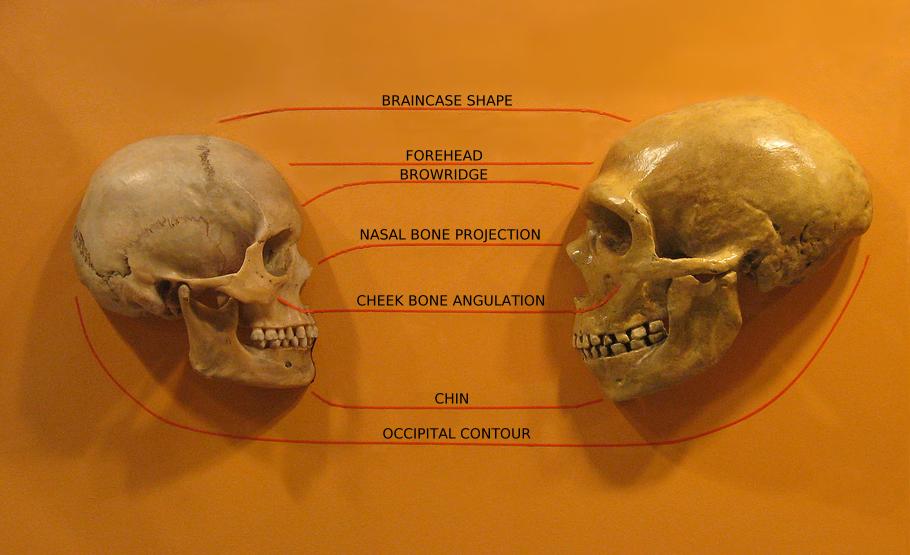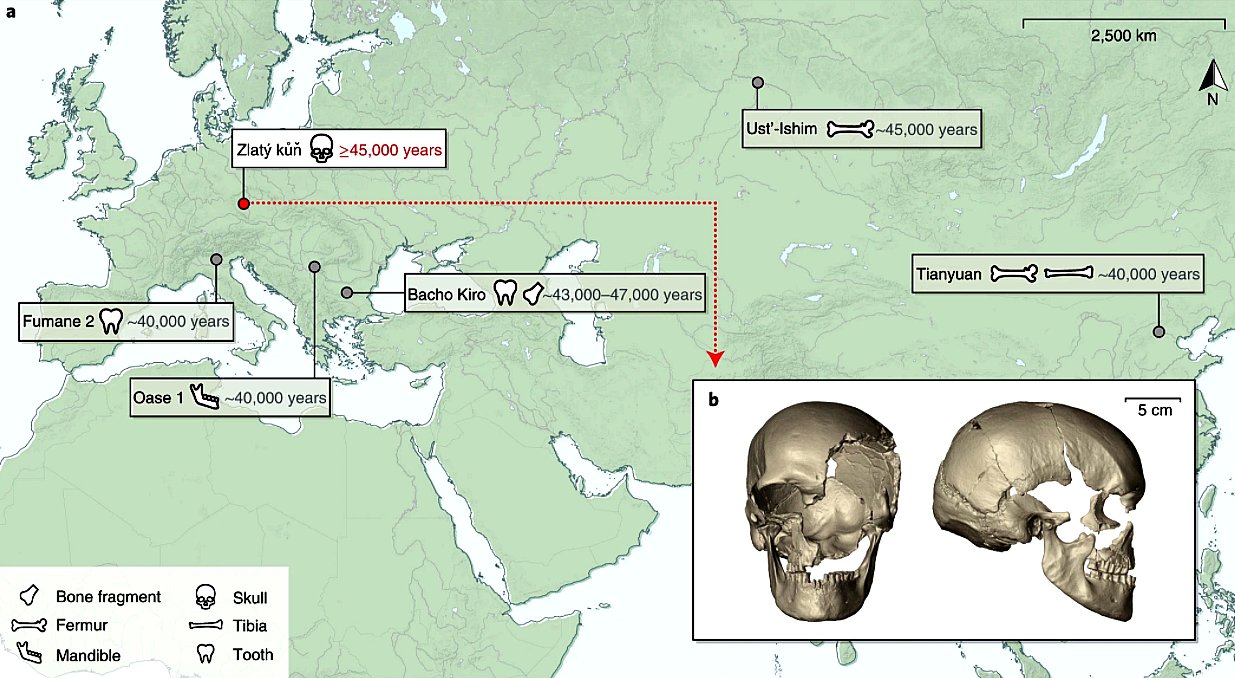Special Neanderthal Update
New evidence Neanderthals deliberately buried their dead
Did Neanderthals intentionally bury their dead? To help resolve this question, a research team presented new data on the La Ferrassie 8 (LF8) Neanderthal from France’s Dordogne region. LF8 is the partial skeleton of a two-year-old Neanderthal child found at the La Ferrassie rock shelter in the 1970s.
The authors reported that the remains were “very well preserved, despite belonging to a child which are generally more delicate.” Also, “the absence of carnivore marks, the low degree of spatial disturbance, fragmentation, and weathering suggest that they were rapidly covered by sediment.” After considering all their data, the researchers concluded:

… that a burial is the most parsimonious explanation for LF8. Our results show that LF8 is intrusive within an older (and archaeologically sterile) sedimentary layer. We propose that Neanderthals intentionally dug a pit in sterile sediments in which the LF8 child was laid. The skeleton was laid in an E (head)–W (pelvis) orientation (as are all the Neandertal skeletons found in the site for which we have information), with the head higher than the rest of the skeleton … .
This new evidence confirming that Neanderthals intentionally buried their dead adds yet more to the list of finds (see creation.com/apeman) indicating that Neanderthals were fully human descendants of Adam and Eve.
- Balzeau, A. and 13 others, Pluridisciplinary evidence for burial for the La Ferrassie 8 Neandertal child, Scientific Reports 10:21230, 9 Dec 2020.
Neanderthals and Homo sapiens used the same Nubian Technology

A multinational study re-examined a fossil and associated stone tools of the collections from Shukbah Cave in the Levant. The cave site was subject to extensive excavations in 1928. The fossil consisted of a single lower first molar tooth of a child. It was said to show “clear Neanderthal affinities”. The associated stone tools included what are known as Nubian Levallois points and cores. These types of tools were previously considered as exclusively made and used by Homo sapiens—i.e. modern type humans. The underlying assumption has been that this technology was too ‘advanced’ to have been made by allegedly ‘less evolved’ groups such as Neanderthals.
The authors stated that their “results indicate that any direct link between Nubian Levallois technology and Homo sapiens can no longer be assumed.” The Max Planck Society quoted Prof Simon Blockley as saying that the study “issues a timely note of caution that there are no straightforward links between particular hominins and specific stone tool technologies.”
Blinkhorn et al. noted that their finding represents the “first direct association between Neanderthals and Nubian Levallois technology”. They said it demonstrates “that this stone tool technology should not be considered an exclusive marker of Homo sapiens.”
This is one more piece of the accumulating evidence about Neanderthals consistent with the creationist view—i.e. that they were fully human descendants of Adam and Eve. That is, they are also in the same kind, Homo sapiens. They were not ‘primitive apemen’ or brutish, subhuman, distant cousins to ‘true humans’.
- Max Planck Society, Neanderthals and Homo sapiens used identical Nubian technology; phys.org, 15 Feb 2021.
Neanderthals heard and spoke just like modern humans
An international multidisciplinary team recently published a paper which examined Neanderthal and modern human skulls. They were trying to answer “one of the central questions in human evolutionary studies.” That is, whether any supposed human ancestor could speak—including the Neanderthals.
Virtual 3-D models of the ear structures of Homo sapiens and Neanderthals were made using CT scans. They were then tested using auditory software to calculate the hearing abilities up to 5 KHz. This “encompasses most of the frequency range of modern human speech sounds.” Neanderthals’ ability closely mirrored that of modern humans.

Furthermore, they were able to calculate the ‘occupied bandwidth’ (the frequency range of maximum sensitivity). In humans this allows us to perceive a wide range of acoustic signals, including consonants, crucial for fully developed language. Here too the Neanderthals’ range was similar to those of humans today.
The similar hearing and bandwidth of Neanderthal hearing “really is the key,” said Mercedes Conde-Valverde. This shows that they “possessed a communication system that was as complex and efficient as modern human speech.”
The belief that Neanderthals were somehow more primitive is massively out of date. Among other things, they buried their dead, made jewellery, manufactured pitch, built domiciles outside of caves, made clothing from animal skins, and interbred with sapiens-type humans. They were post-Babel descendants of Noah who had the same anatomical design to communicate as any other human.
- Conde-Valverde, M, and 9 others, Neanderthals and Homo sapiens had similar auditory and speech capacities, Nat. Ecol. Evol., 1 Mar 2021.
- Binghamton University, New research shows Neanderthals had the capacity to perceive and produce human speech, scitechdaily.com, 1 Mar 2021.
More interbreeding between Neanderthals and modern humans
Modern humans supposedly arrived in Europe around 45 thousand years ago (ka). Evolutionists believe Neanderthals disappeared by about 40 ka, leaving a few thousand years when both modern humans and Neanderthals lived in Europe at the same time. Two recent papers presented genomic analysis of some of the allegedly earliest modern humans in Europe. Hajdinjak et al. presented data from three individuals from Bacho Kiro Cave, Bulgaria (dated to between 45.93 and 42.58 ka), whereas Prüfer et al. analyzed a female skull from Zlatý kůň cave, Czechia (dated to ~45 ka).

It was found that the three Bacho Kiro Cave individuals (comprising a molar and two bone fragments) carried 3.0%–3.8% Neanderthal DNA. Hajdinjak et al. said that these individuals were “more closely related to present-day and ancient populations in East Asia and the Americas than to later west Eurasian populations.” The genome of the skull from Czechia carried about 3% Neanderthal DNA, and according to Prüfer et al. “belonged to a population that appears to have contributed genetically neither to later Europeans nor to Asians.” Callaway mentions Viviane Slon, a paleogeneticist at the University of Tel Aviv, as stating that the “research adds to growing evidence that modern humans mixed regularly with Neanderthals and other extinct relatives.” Yet more proof that Neanderthals were fully human.
The Czechian skull has been radiocarbon dated several times, yielding approximate dates of 15, 27, 19, and 34 ka. But Callaway says that “on the basis of its Neanderthal ancestry, Krause [co-leader of the study] suspects it is well over 45,000 years old.” The radiocarbon dates, which would not fit the standard evolutionary tale, are conveniently rejected as being artificially young from supposed contamination.
- Callaway, E. Oldest DNA from Homo sapiens reveals surprisingly recent Neanderthal ancestry, nature.com, 7 Apr 2021.
- Hajdinjak, M. and 31 others, Initial Upper Palaeolithic humans in Europe had recent Neanderthal ancestry, Nature 592:253–257, 8 Apr 2021.
- Prüfer, K. and 10 others, A genome sequence from a modern human skull over 45,000 years old from Zlatý kůň in Czechia, Nature Ecol. Evol., 7 Apr 2021.


Readers’ comments
Comments are automatically closed 14 days after publication.